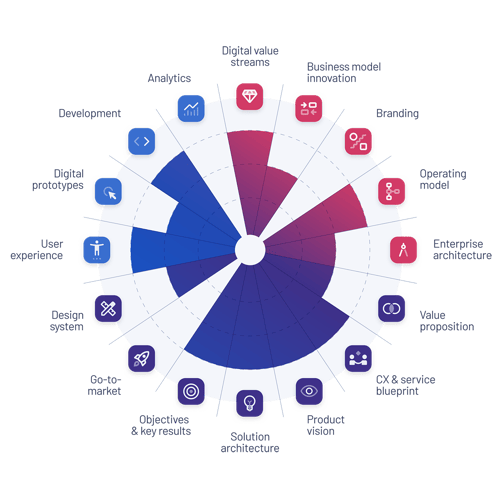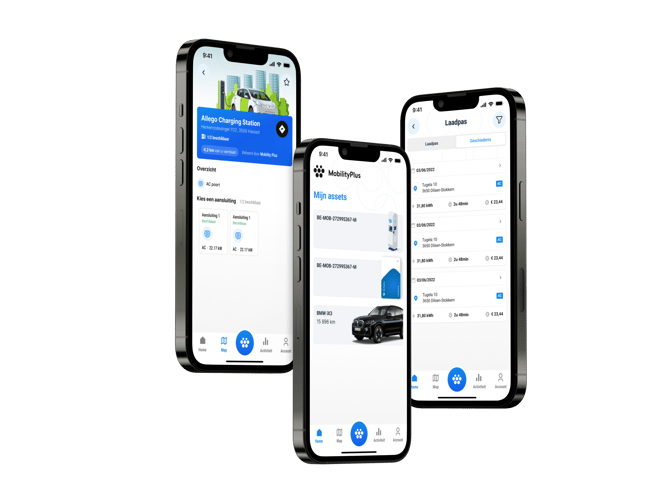Ready to create a digital experience your users will love?
Let’s create digital products with real impact. We are happy to support you from idea to launch!

We team up with people who have big ideas and even bigger goals.
From early-stage concepts to complex digital ecosystems, we help you move faster, smarter and with more confidence.


You have the vision and we help you bring it to life. We turn bold ideas into strong omnichannel experiences and launch scalable, high-impact digital products, fast.


Let’s level up what’s already working. We optimize the value, experienc and performance of your digital products. Fast, incrementally and where it matters most.


Got strategy but no traction? We’ve got you.
We help you uncover high-potential digital value streams and turn strategic vision into an actionable battle plan.
Let's turn bold ideas into strong omnichannel experiences and launch scalable, high-impact digital products fast.

To truly meet your users where they are, mobile often plays a crucial role.
That’s why our digital product team works hand-in-hand with our mobile experts to create smooth end-to-end experiences, from digital strategy to launch in the app store.

Our work is shaped by a set of core principles that guide us in everything we do. These are more than just catchphrases; they characterize our way of thinking, working together, and producing outcomes. As a team, they embody our values: visionary, pragmatic, and unwaveringly value-focused.


We see both the forest and the trees. We get into the details, but always with the bigger picture in mind. Business, solution or product strategy, we switch context fast and keep it all aligned.


We solve complex problems by working together and bring in diverse perspectives and the right mix of skills. It’s a multidisciplinary approach without the unnecessary complexity or overhead.


Our decisions are driven by data. We trust in evidence to guide our strategies and keep everything we do supported by insights and analysis, not gut instinct or personal opinion.


We design digital experiences that truly have an impact, rather than ‘beautiful screens’. Our drive is to deliver authentic outcomes that improve market performance and real change.


We design with inclusivity and long-term sustainability in mind. Our commitment to ethical practices and social responsibility guides us in creating solutions that serve diverse stakeholders. We build lasting partnerships with our customers and guide them far beyond the initial launch.


Practicality over theoretical perfection. Our iterative process ensures fast experimentation and adaptation based on real-world feedback.
Turn complexity into clarity with a digital strategy rooted in user needs and business goals.
We help define product direction, shape business alignment and validate assumptions before you build.
We prototype, validate and iterate before launch, making sure your end-product delivers real user value.
We build and implement design systems that unify teams and accelerate delivery across all touchpoints.
Intuitive, accessible, and elegant interfaces. Built with your users at the core.
Together we evaluate and enhance the user experience of existing products.
Equip teams with the skills and frameworks needed to execute and manage digital products effectively.
Let’s create digital products with real impact. We are happy to support you from idea to launch!

Let’s create digital products with real impact. We are happy to support you from idea to launch!

Let’s create digital products with real impact. We are happy to support you from idea to launch!

Let’s create digital products with real impact. We are happy to support you from idea to launch!

Dive into our blog for expert tips insights into creating user-centered digital products.


At ACA, Ship-IT Days are no-nonsense innovation days.
Read more

In the complex world of modern software development, companies are faced with the challenge of seamlessly integrating diverse applications developed and managed by different teams. An invaluable asset in overcoming this challenge is the Service Mesh. In this blog article, we delve into Istio Service Mesh and explore why investing in a Service Mesh like Istio is a smart move." What is Service Mesh? A service mesh is a software layer responsible for all communication between applications, referred to as services in this context. It introduces new functionalities to manage the interaction between services, such as monitoring, logging, tracing, and traffic control. A service mesh operates independently of the code of each individual service, enabling it to operate across network boundaries and collaborate with various management systems. Thanks to a service mesh, developers can focus on building application features without worrying about the complexity of the underlying communication infrastructure. Istio Service Mesh in Practice Consider managing a large cluster that runs multiple applications developed and maintained by different teams, each with diverse dependencies like ElasticSearch or Kafka. Over time, this results in a complex ecosystem of applications and containers, overseen by various teams. The environment becomes so intricate that administrators find it increasingly difficult to maintain a clear overview. This leads to a series of pertinent questions: What is the architecture like? Which applications interact with each other? How is the traffic managed? Moreover, there are specific challenges that must be addressed for each individual application: Handling login processes Implementing robust security measures Managing network traffic directed towards the application ... A Service Mesh, such as Istio, offers a solution to these challenges. Istio acts as a proxy between the various applications (services) in the cluster, with each request passing through a component of Istio. How Does Istio Service Mesh Work? Istio introduces a sidecar proxy for each service in the microservices ecosystem. This sidecar proxy manages all incoming and outgoing traffic for the service. Additionally, Istio adds components that handle the incoming and outgoing traffic of the cluster. Istio's control plane enables you to define policies for traffic management, security, and monitoring, which are then applied to the added components. For a deeper understanding of Istio Service Mesh functionality, our blog article, "Installing Istio Service Mesh: A Comprehensive Step-by-Step Guide" , provides a detailed, step-by-step explanation of the installation and utilization of Istio. Why Istio Service Mesh? Traffic Management: Istio enables detailed traffic management, allowing developers to easily route, distribute, and control traffic between different versions of their services. Security: Istio provides a robust security layer with features such as traffic encryption using its own certificates, Role-Based Access Control (RBAC), and capabilities for implementing authentication and authorization policies. Observability: Through built-in instrumentation, Istio offers deep observability with tools for monitoring, logging, and distributed tracing. This allows IT teams to analyze the performance of services and quickly detect issues. Simplified Communication: Istio removes the complexity of service communication from application developers, allowing them to focus on building application features. Is Istio Suitable for Your Setup? While the benefits are clear, it is essential to consider whether the additional complexity of Istio aligns with your specific setup. Firstly, a sidecar container is required for each deployed service, potentially leading to undesired memory and CPU overhead. Additionally, your team may lack the specialized knowledge required for Istio. If you are considering the adoption of Istio Service Mesh, seek guidance from specialists with expertise. Feel free to ask our experts for assistance. More Information about Istio Istio Service Mesh is a technological game-changer for IT professionals aiming for advanced control, security, and observability in their microservices architecture. Istio simplifies and secures communication between services, allowing IT teams to focus on building reliable and scalable applications. Need quick answers to all your questions about Istio Service Mesh? Contact our experts
Read more

Let’s begin this blog post by remembering embarrassing memories from our past. Remember when you called your teacher “mom” in kindergarten? Or that huge zit on your forehead on your first day of high school? Let’s have a look at a picture from a couple of years ago. Those clothes… those hideous clothes. Why did you think you’d rock those super tight pants forever? Well.. you’ve changed and so did those fashion trends. Trends also seem to change quite rapidly in other kinds of design. In this blogpost, I’ll walk you through 3 tips to modernize your handout design and improve an old print design to fit in the modern world. I’m using a recent redesign of a handout made for our mobile team as an example. 1. Go digital The biggest change in this redesign is that we’re actually stepping away from print and moving towards digital media, such as a PDF file. A couple of advantages go hand in hand here. You no longer have to worry about how you’re going to jam all your information on two A4 pages, since you aren’t limited to a certain page size . This gives you more freedom with both your structure and information placement. As you can see in our example (click the picture on the right), this results in a lighter design that’s much more enjoyable to read because of extra whitespace between sections. Another big improvement is the ability to make use of links . You don’t have to write a full URL anymore, because you can just click on a shorter one or even add a button like you’re designing a webpage. Try adding links to logos or pictures. By doing this, you’re changing a completely static object into a link to even more information. Your handout is no longer limited to just the information on your two pages. Be careful you don’t forget to add links to anything that seems ‘clickable’ though. If your user tries to click on something that should’ve been a redirect to for example your website and it doesn’t work, you don’t make a good impression. 2. Add more whitespace! First things first, whitespace doesn’t need to be ‘white’ space. Whitespace refers to empty breathing room in your design , not a white colour between design elements. Imagine getting a page to read and everything is cropped in the first half of the page. I’d rather gouge my eyes out than try to read that. Space out your information and use that empty space to improve the reader’s experience and even guide them to parts you want them to read. In other words, empty space makes your content more readable. When your focus is to inform your reader, readability is top priority . In our old design, we used an abstract background. Pictures or patterns can be used as whitespace but aren’t ideal if you’re going for a professional and clean look. We simply changed to a white background instead. This way, we structured our design in a couple of ‘information containers’. The whitespace makes sure each of those containers gets the focus it deserves. So don’t just read whitespace and see it as unused space. Think of whitespace as a guide for your reader . 3. Don't overdo it You want to tell your audience something, so get to the point . Don’t try to over-explain and don’t use words you even barely know to sound smart. The same goes for showing pictures and using design elements. Nobody wants to scroll through 10 pictures which all show the same thing to find information they need. Say what you need to say and show what you need to show. Also, try using a number instead of an icon when speaking about a certain percentage for example. People love numbers (just look at all those infographics floating around on the internet as proof). Try to have a nice balance between icons and percentages when designing something. Of course, there’s nothing wrong with using icons as a visual too. They can break your wall of text, make it more enjoyable to reed and keep the reader interested. Last but not least, your design isn’t a child’s coloring book. Don’t use all of the crayons available! We went way overboard in our previous design. Now we’re only using red as our main color because it’s also the main color of ACA’s corporate identity. If you really want to use more color in your new design, be consistent . Don’t give your first title a blue color while giving your other titles a purple color. It’s pretty basic really, but often overlooked. 🚀 Takeaway Print design isn’t exclusively for just print anymore in today’s digital world. If you want to update your previous print designs so they fit in our online lives as well, here are some things you should take into account: Forget strict page size limits. Include clickable links in your design. You can even add buttons like on a website. Use as much whitespace as you need to help your reader ‘breathe’ for a second and rest their eyes. Be brief! Include visuals, but stay consistent in your color palette.
Read more